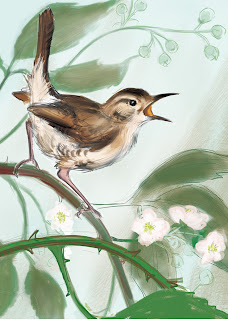There is something valiant about Jenny, Kitty-me-wren or Our Lady’s Hen. She is our most common breeding bird, a little bird of the earth that stalks us on our walks around the garden. She never flies very high, we catch occasional glimpses of her skulking out of sight, poking about in holes and peering under things, disappearing and reappearing in amongst the tree roots and in the bramble patches. The male Wren will build up to eight nests to attract his bride to be, and he is amongst the first up in the morning to guard his territory with a loud clear voice that is amongst the most complex in the bird kingdom. They are tiny, they are everywhere except wide open spaces, but we still find them in scrub on remote barren islands.
We have forgotten that the wren was once the central object of worship not just in Britain but in every European nation. In Ireland they have medieval manuscripts telling us how to read the speech of the wren. The Welsh called them “Dryw”, which is also their word for druid and soothsayer, because this bird was sacred to the druids, it is thought they were kept in cages as oracles. The English word Wren is derived from Drian, ie Draoi-en, “The Druid’s Bird” (from the proto-Celtic Drevo, cognate with the English “true”).
Her nobility was ambiguous and had many forms, she was a symbol of the earth that sometimes usurped the Eagle, the sun and rightful “the king of the birds”. In the Mabinogion, an ancient Welsh masterpiece, a hero called Llew who slays wrens is slain himself. His body is transformed into an Eagle with the wren on its back, just as one year runs into the next. Thus we find this symbolism that the wren is the spirit of the the earth, the old year killed at the winter solstice and reborn again to soar like the Sun and the Eagle into the coming Spring. In many Celtic communities they had wren hunts at the Winter solstice and afterwards they paraded their little bodies on sticks around villages, exchanging their feathers for tokens. In parts of France they would dress her in the apparel of hawks,
The earliest stories of her trickery are 4000 years old and come from Sumeria, they tell of a wren who outwitted an elephant. Aesop (600 BCE) is the earliest credited source of the a fable about a congress of birds which had gathered to choose their king, and to this end they had organised a competition to find the bird that could fly the highest. Of course the Eagle soured higher than any other bird could manage, and so the confident Eagle looked down and said “look I am your King“. Suddenly, the little wren, who had hidden himself in the feather’s of the Eagles crest, flew a few inches higher and chirped “Birds look up and behold your King“. Across Europe abundant variants and sequels of these stories survive, they are found in the Brothers Grimm and Shakespeare, stories of angry birds and blundering owls who Jenny always outwitted, but sometimes paying a price; she lost half her tail when the Eagle in his rage slammed her to the ground and was forever banned by the other birds from ever flying higher than the Hawthorn bush.
Her kingship is celebrated across Europe in her name; the latin word for wren is Regulus; Greek Basiliskos (Little King); French Roilet (Little King) and Roi de froidure (Cold Weather King); Italian Reatino (Little King); Swedish Kungs Fogel (Kings Fowl); Danish Elle-Konge (Alder King); Dutch Konji (King) and Winter-koninkje (Little Winter King); German Zaunkonig (Hedge King) and Schneekonig (Snow King). To this day the Bretons have a proverb “The Eagle flees before the Wren“.
Amongst the many names from around the British Isles are: Kitty-me-wren, Wran, Wrannock, Cutty, Cuddy, Scut, Scutty, Stumpy Dick, Cracket, Carckadee, Tit wren, Tom Thumb and St Mary’s Hen and Little Brown Nut (Shetlands)
Buy the Greeting Card –

